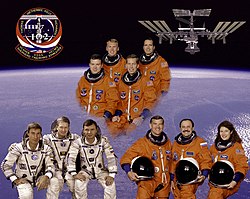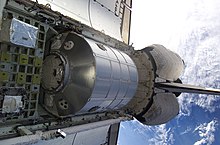STS-102
| Mission emblem | |||
|---|---|---|---|

|
|||
| Mission dates | |||
| Mission: | STS-102 | ||
| COSPAR-ID : | 2001-010A | ||
| Crew: | 7th | ||
| Begin: | March 8, 2001, 11:42:09 UTC | ||
| Starting place: | Kennedy Space Center , LC-39B | ||
| Space station: | ISS | ||
| Coupling: | March 10, 2001, 06:38:00 UTC | ||
| Decoupling: | March 19, 2001, 04:32:00 UTC | ||
| Duration on the ISS: | 8d 21h 54min 00s | ||
| Landing: | March 21, 2001, 07:31:42 UTC | ||
| Landing place: | Kennedy Space Center, Lane 15 | ||
| Flight duration: | 12d 19h 49min 33s | ||
| Earth orbits: | 201 | ||
| Track height: | 226 - 320 km | ||
| Covered track: | 8.62 million km | ||
| Payload: | MPLM Leonardo , external stowage platform (ESP-1) | ||
| Team photo | |||
 Crew of the space shuttle mission STS-102 (top), the crew of ISS expedition 1 (bottom left) and the crew of ISS expedition 2 (bottom right). |
|||
| ◄ Before / After ► | |||
|
|||
STS-102 ( english S pace T ransportation S ystem ) is the mission designation for a flight of the US Space Shuttle Discovery (OV-103) of NASA . The launch took place on March 8, 2001. It was the 103rd space shuttle mission, the 29th flight of the space shuttle Discovery and the 8th flight of a shuttle to the International Space Station (ISS).
team
Shuttle crew
- James Wetherbee (5th space flight), commander
- James Kelly (1st space flight), pilot
- Paul Richards (1st spaceflight), mission specialist
- Andrew Thomas (3rd spaceflight), mission specialist
ISS crew outward flight
-
Yuri Usachev ( Russia ) (4th space flight), commander

- Susan Helms (5th spaceflight), flight engineer
- James Voss (5th spaceflight), flight engineer
replacement
-
Yuri Onufrijenko ( Russia ) for Ussachev

- Daniel Bursch and Carl Walz for Helms and Voss
ISS crew return flight
- William Shepherd (4th space flight), commander
-
Yuri Gidsenko ( Russia ) (2nd space flight), flight engineer

-
Sergei Krikaljow ( Russia ) (5th space flight), flight engineer

(Returned to Earth after a flight time of 140 days, 23 hours and 39 minutes; one way flight on Soyuz TM-31 )
Mission overview
In addition to other scientific equipment, the team delivered one of the three Italian multi-purpose logistics modules with experiments for the laboratory module Destiny to the International Space Station under construction for the first time . In total, the Discovery was docked at the station for almost nine days, while the crew did preparatory work with two exits (EVAs) . a. for the robot arm Canadarm2 arriving with the next mission ( STS-100 ) . Furthermore, the first permanent ISS crew was replaced by new personnel on this flight. The first exit, at 8 hours and 56 minutes, was the longest spacecraft to date.
Mission history
The Discovery docked on March 10th at 6.38 a.m. UTC at the forward docking assembly of the International Space Station. The station's solar panels had previously been locked in a certain position. This location offered the greatest assurance that the solar cells would not be damaged by the shuttle's engine exhaust. There was a one hour delay here.
The first crew change on the International Space Station took place during the STS-102 mission . The second crew consisted of the Russian commander Yuri Usachev and the US astronauts Susan Helms and James Voss. The transfer took place in several stages. First, Yuri Usachev moved to the station and replaced the Soyuz pilot Yuri Gidzenko. The commanders of the first and second permanent crews, William Shepherd and Yuri Ussachev, then stayed four days for the handover. They talked about the work that had been done so far as well as about special features and problems. Then the focus was on unloading work and installations.
With the Discovery, 7 racks with system components and experiments entered the US laboratory module Destiny. Two racks contained energy converters that provide various voltages for the control and experiment devices on board the station. Two further racks contained the control systems for the Canadian manipulator arm and its four cameras. The other two racks contained systems for operating the Ku-band communication system and emergency medical equipment. This included a defibrillator and an ultrasound device. In addition, 3 reusable storage space elements and several containers with supplies changed into the station. Eventually the first science rack was installed in Destiny. Medical research is carried out with the Human Research Facility. The members of the ISS Expedition 2 carried out the first scientific studies on board the Discovery on the second day of the flight. In the Hoffmann reflex experiment, the reaction speed of the spinal cord was examined. A special stimulus to the leg muscles led to an immediate reaction. From the change in the reaction time during and after the adjustment to weightlessness, conclusions could be drawn about the processing of stimuli in the spinal cord. The experiment was repeated on the sixth day of flight. The apparatus was then brought to the station, where further tests followed.

All racks were housed for transport in a logistics module ( MPLM - MultiPurpose Logistics Module ) developed and built in Italy , which was first used on this mission. The logistics module called Leonardo has its own ventilation, cooling and lighting systems. It is 6.4 meters long, cylindrical with a diameter of 4.6 meters. Its empty weight is around 4.1 t. It can hold up to 9.1 t payload in 16 racks. A maximum of 5 racks can be internally supplied with energy from the start to the docking of the space shuttle or after decoupling until landing. This made it possible to transport frozen samples for biomedical experiments. With Raffaello and Donatello, Leonardo has two identical brothers, one of whom, however, Donatello was never used.
Leonardo was lifted out of the cargo bay on March 12th and docked on the underside of the Unity ISS module . To do this, the coupling adapter PMA 3 had to be recoupled the day before. This happened on the first spacecraft mission (Voss and Helms, 8:56 h). In doing so, the astronauts first disconnected several data and power cables. In addition, a communication antenna on the port side of Unity was dismantled, a work platform was attached to Destiny and a base for the Canadian manipulator was installed. This was brought into orbit in April with the Endeavor ( STS-100 ). Finally, Voss and Helms installed a cable duct for the supply lines to the manipulator. The planned work could not be completed because Voss initially lost a connector. It was replaced by a spare part.
After James Voss and Sergej Krikaljow swapped places on March 12 and the logistics module was opened, the mixed station crew began unloading the voluminous "moving container".
At the second exit of the mission (6:21 h), Thomas and Richards first brought the work of Voss and Helms to a conclusion on March 13 by connecting several cables to the newly installed base. They then mounted a storage platform on Destiny and connected a container to the external power supply. An electric heater ensures that devices stored here do not freeze. Thomas and Richards then installed a reserve pump for the external coolant circuit. Then they inspected a defective measuring device for electrical charges, "climbed" the top of the solar cell mast, locked a locking mechanism on one of the port panels, checked and photographed the outside of the station, in particular a defective fan and a connector.
On March 14th, the commander of the first permanent crew, William Shepherd, moved to the Discovery and Susan Helms to the station. After that, all space travelers participated in the transport of supplies and equipment as well as in the installation of the new systems. Due to the risk of collision with the part of the connection that was lost on the first exit, the first of three planned lifts was brought forward by one day. The other orbit maneuvers took place on March 16 and 17. It was also decided to extend the flight by one day so that the cargo for the return flight could be accommodated more evenly in the logistics module. Around a ton of rubbish and packaging material was brought back to earth.
The scientific program on board the Discovery mainly consisted of automatically running biological experiments by American students of different age groups. A total of 21 containers with seeds were on board (SEEDS experiment), the germination of which took place in weightlessness. Afterwards, the growth of these seedlings was compared with normal tomato, soybean and cereal plants on earth.
On March 18, MPLM Leonardo was disconnected from Unity and stowed in the shuttle's hold. The following day the Discovery cast off from the station, circled it once, and then slowly moved away from it. After the usual preparations for landing, which this time also included the installation of three special seats for the long-term flyers in the middle deck, the space shuttle landed on the grounds of the Kennedy Space Center at night.
See also
Web links
- NASA Mission overview (English)
- NASA website of the Mission (English)
- NASA video of Mission (English)
- Video summary with comments of the crew (English)



